History of Tourism and Villas in Croatia
3rd century BC - first Roman villas in Istria and Dalmatia
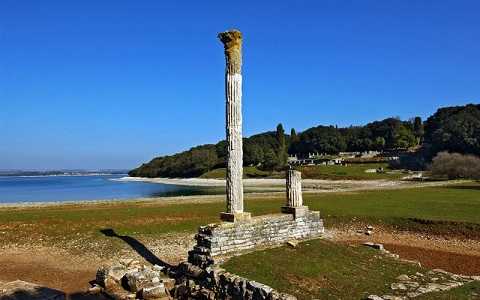
Villa as a type of building originate over 2,200 years ago at the end of 3rd or early 2nd century BC. The villa architecture was first inspired by the tradition Etruscan and Roman elite buildings. Hellenistic influence in 1st century BC has brought many innovations to this basic type - a yard with a peristyle and a long portico with significant visuals that evoke the antique style of the Roman Villa from the Italian residential tradition. Originally, this is a traditional Mediterranean house with an atrium (central courtyard) and is found in the bases of most Roman villas.
A villa rustica is a Roman building with an exterior housing and an economic building, warehouse, workshops, located in the center of the estate, the usual form of settlements of the rural area in the Roman environments. They appear at the end of the Roman Republic in Italy, then expanded to the coast of the Adriatic with the Romanization of ager colonies (Pula, Parentium, Tergeste) in the 1st century BC, especially at the end of the 1st century BC.
A villa rustica is a Roman building with an exterior housing and an economic building, warehouse, workshops, located in the center of the estate, the usual form of settlements of the rural area in the Roman environments. They appear at the end of the Roman Republic in Italy, then expanded to the coast of the Adriatic with the Romanization of ager colonies (Pula, Parentium, Tergeste) in the 1st century BC, especially at the end of the 1st century BC.

In Istria there are several hundred (250-300) localities with villa rustica remains, almost all along the sea shore or in a narrow belt of a few kilometers from the sea. The most numerous were villas with the equal residential and production facilities (wineries, oil mills, rolling mills etc.).
Villas with luxurious features of the palace were rare like rich owner's residences (Brijuni, Valbandon, Barbariga, Katoro, Sorna), recognizable by the existence of expensive ornaments equipped with heating system, hot baths, floor and wall mosaics, frescoes, sculptures and other stone plastics.
These were summer residences of rich social layers (eg Hadrian's villa in Tivoli, villa on Veli Brijun). In the architectural sense the villas can be classified in three types: villas with corridor, villas with central courtyard and villas of the basilic type. In the late antique period, they were often found surounded with stone walls with towers on corners.
Villas with luxurious features of the palace were rare like rich owner's residences (Brijuni, Valbandon, Barbariga, Katoro, Sorna), recognizable by the existence of expensive ornaments equipped with heating system, hot baths, floor and wall mosaics, frescoes, sculptures and other stone plastics.
These were summer residences of rich social layers (eg Hadrian's villa in Tivoli, villa on Veli Brijun). In the architectural sense the villas can be classified in three types: villas with corridor, villas with central courtyard and villas of the basilic type. In the late antique period, they were often found surounded with stone walls with towers on corners.

Some villas became centers of major agglomerations of refugee features, and some developed into new urban or rural settlements.
In Croatia, the remains of Roman villas are the most numerous in the Istrian area (Brijuni, Valbandon, Katoro, Barbariga, Červar-Porat), but also along the entire Adriatic coast in Dalmatia and on the islands (Murter, Mljet) as well as in the Pannonian area (Drenje, Bartolovec, Benkovac, Osekovo).
Roman early-style villas combine the Italian architectural tradition, delightful luxury and elegance of Hellenistic architecture and imposing Egyptian style. Buildings are regularly in selected locations, fully customized landscaping in suitable deep bays or elevated hillside locations, with wide visions to the surrounding terrain and approaches.
In Croatia, the remains of Roman villas are the most numerous in the Istrian area (Brijuni, Valbandon, Katoro, Barbariga, Červar-Porat), but also along the entire Adriatic coast in Dalmatia and on the islands (Murter, Mljet) as well as in the Pannonian area (Drenje, Bartolovec, Benkovac, Osekovo).
Roman early-style villas combine the Italian architectural tradition, delightful luxury and elegance of Hellenistic architecture and imposing Egyptian style. Buildings are regularly in selected locations, fully customized landscaping in suitable deep bays or elevated hillside locations, with wide visions to the surrounding terrain and approaches.
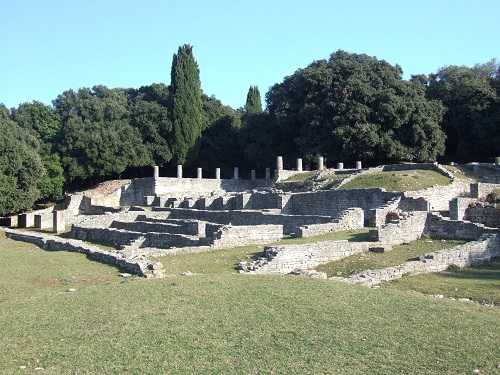
They are characterized by good communication with the nearest urban centers, safe harbors and position on important roads or sailing routes.
In the area of Dalmatia and Istria there are many sites of Villas and Villages but only a small number of sites have been researched.
Significant villas, whether explored or partially investigated are located in Histriae (Istria): Loron, Porat, Červar and Sorna near Poreč, Barbariga and Fažana, luxury villa on Brijuni islands, Valbandon, Banjole and Vižula (Medulin) near Pula.
In Roman Dalmatia; Muline on the island of Ugljan, along the coast below Mount Velebit, on the islands of Krk, Cres, Unije, Pag, Rab and Murter, in Biograd and Benkovac, Orlic near Knin, Puntamika, Pridrama and Kašić near Zadar, large luxury villa with special floor plan from the second half of the 1st century in the bay of Stari Trogir and Bijaći (Sicula) near Salona. Urban villa close to Porta Cesare in Salona is known under the name Provincial Governor's Palace.
Significant villas, whether explored or partially investigated are located in Histriae (Istria): Loron, Porat, Červar and Sorna near Poreč, Barbariga and Fažana, luxury villa on Brijuni islands, Valbandon, Banjole and Vižula (Medulin) near Pula.
In Roman Dalmatia; Muline on the island of Ugljan, along the coast below Mount Velebit, on the islands of Krk, Cres, Unije, Pag, Rab and Murter, in Biograd and Benkovac, Orlic near Knin, Puntamika, Pridrama and Kašić near Zadar, large luxury villa with special floor plan from the second half of the 1st century in the bay of Stari Trogir and Bijaći (Sicula) near Salona. Urban villa close to Porta Cesare in Salona is known under the name Provincial Governor's Palace.
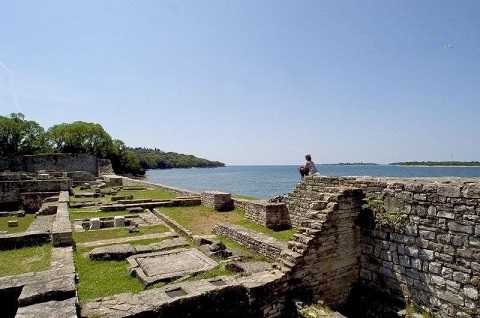
On the island of Šolta there are numerous villas (Rogač-Banje, Necujam etc.), Brač island (especially Povlja, Lovrečina, Bol), Hvar island (“ager” between Stari Grad and Jelsa).
Many villas are located along the Makarska coast, in Erešovo near Narona on the coast of Pelješac peninsula (Žuljana and Orebic), the island of Korcula (large luxury villa with opus reticulatum in Lumbarda).
The villas were explored on the islands of Koločep, Lopud and Sipan. Two luxurious Roman villas are located near Epidaurus, today Cavtat (in the bay of Tiha and on the peninsula of Sustjepan) as well as numerous villas near Slano and Ston.
The number of 233 places where villas are identified or explored in Istria and Dalmatia, Croatia is quite impressive.
Many villas are located along the Makarska coast, in Erešovo near Narona on the coast of Pelješac peninsula (Žuljana and Orebic), the island of Korcula (large luxury villa with opus reticulatum in Lumbarda).
The villas were explored on the islands of Koločep, Lopud and Sipan. Two luxurious Roman villas are located near Epidaurus, today Cavtat (in the bay of Tiha and on the peninsula of Sustjepan) as well as numerous villas near Slano and Ston.
The number of 233 places where villas are identified or explored in Istria and Dalmatia, Croatia is quite impressive.

Their density and number point to significance of the area in which they are located. Southern part of Istria near the ancient Pula is remarkable.
A large number of luxury villas (Barbariga, Brijuni, Vižula, Valbandon), in the area can be compared to the bay of Naples (Antique Stabiae, Baiae, Capri, Sorrentum).
Similarly higher density of representative villas is located near major city centers – Salona near Split, Narona and Epidaurus, which confirms the theory that members of a rural structure could be at the same time an urban elite.
Some Medieval settlements were based on the ruins of Roman villas, or in their vicinity, especially in southern Istria (Marčana, Ližnjan, Štinjan, Vodnjan, Šišan, Filipana and others). These examples show that the architecture of the Villa in Istria and Dalmatia in its scope and quality is not lagging behind in the areas of Italy.
Similarly higher density of representative villas is located near major city centers – Salona near Split, Narona and Epidaurus, which confirms the theory that members of a rural structure could be at the same time an urban elite.
Some Medieval settlements were based on the ruins of Roman villas, or in their vicinity, especially in southern Istria (Marčana, Ližnjan, Štinjan, Vodnjan, Šišan, Filipana and others). These examples show that the architecture of the Villa in Istria and Dalmatia in its scope and quality is not lagging behind in the areas of Italy.
14th century - Renaissance villas in Dubrovnik Republic

The general prosperity of the pre-Renaissance Dubrovnik and its openness to the humanistic streams led to the acceptance of new forms in the culture of living by Dubrovnik aristocracy and wealthy citizens, among which a special place occupies the summer holiday homes.
The erection of well-built stone houses in the suburbs of Dubrovnik , intended for a stay on the tour of land property and the pre-epidemic pilgrimage, was recorded in the 14th century.
St. Filip de Diversis in 1440 in the description of the famous city of Dubrovnik states that the Gruž Bay is surrounded by fine-built houses and beautiful gardens, which points to the beginning of the holiday villas in Dubrovnik. Benedict Kotrulj in the Book of Commerce (1458) points out that a prominent merchant with an appropriately decorated house in the city should also possess a villa on his country estate.
The construction of Renaissance summer holiday homes in the vicinity of Dubrovnik appeared at the end of 15th century, and continued intensively throughout the 16th century, and somewhat later. Due to the Gothic suburban houses that have just been built, the summer houses are more comfortable, more interestingly built, equipped with more exquisite stone plastics and inventory. As a rule, these are single-walled stone buildings of a measured size and most often with a rectangular floor plan.
The erection of well-built stone houses in the suburbs of Dubrovnik , intended for a stay on the tour of land property and the pre-epidemic pilgrimage, was recorded in the 14th century.
St. Filip de Diversis in 1440 in the description of the famous city of Dubrovnik states that the Gruž Bay is surrounded by fine-built houses and beautiful gardens, which points to the beginning of the holiday villas in Dubrovnik. Benedict Kotrulj in the Book of Commerce (1458) points out that a prominent merchant with an appropriately decorated house in the city should also possess a villa on his country estate.
The construction of Renaissance summer holiday homes in the vicinity of Dubrovnik appeared at the end of 15th century, and continued intensively throughout the 16th century, and somewhat later. Due to the Gothic suburban houses that have just been built, the summer houses are more comfortable, more interestingly built, equipped with more exquisite stone plastics and inventory. As a rule, these are single-walled stone buildings of a measured size and most often with a rectangular floor plan.
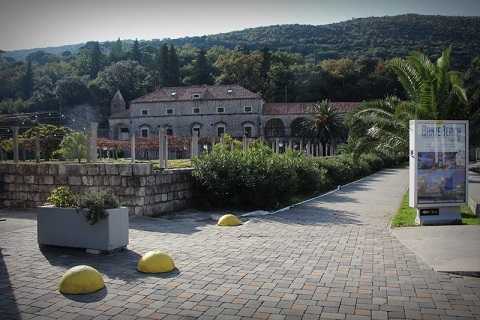
They are distinguished by the refined simplicity and careful selection of position and the unobtrusive attitude toward the surrounding nature, which is testimony to the humanistic awareness of their owners and builders. They have a large enough garden inside with open spaces of the greenery, so they are in the true sense of the Renaissance villa.
During building, special attention was paid to the decoration of the facade. On the clear stone wall of the villas there are fine square shapes of the door and the windows. The windows on the floor are sometimes highlighted with profiled gable. Exceptionally in the first decades of the 16th century, with the appearance of the Knežev dvor and Sponza palace, the facades of the summer houses Bunić-Gradić, P. Sorkočević, Bundić, Pucić in the Gruž Bay and Bunić-Kabo in Batahovina were performed in a transitional Gothic-Renaissance style.
The interior of the villa on the ground floor has a central room, a saloon, from which the entrance to the auxiliary rooms and access to the staircase leads to the main hall on the ground floor. On both sides of the main hall there are usually two rooms. The plots of some villas have become more complex by the addition of more or less elongated ground wings placed perpendicularly along the side of the building, known as the L-floor plan.
During building, special attention was paid to the decoration of the facade. On the clear stone wall of the villas there are fine square shapes of the door and the windows. The windows on the floor are sometimes highlighted with profiled gable. Exceptionally in the first decades of the 16th century, with the appearance of the Knežev dvor and Sponza palace, the facades of the summer houses Bunić-Gradić, P. Sorkočević, Bundić, Pucić in the Gruž Bay and Bunić-Kabo in Batahovina were performed in a transitional Gothic-Renaissance style.
The interior of the villa on the ground floor has a central room, a saloon, from which the entrance to the auxiliary rooms and access to the staircase leads to the main hall on the ground floor. On both sides of the main hall there are usually two rooms. The plots of some villas have become more complex by the addition of more or less elongated ground wings placed perpendicularly along the side of the building, known as the L-floor plan.
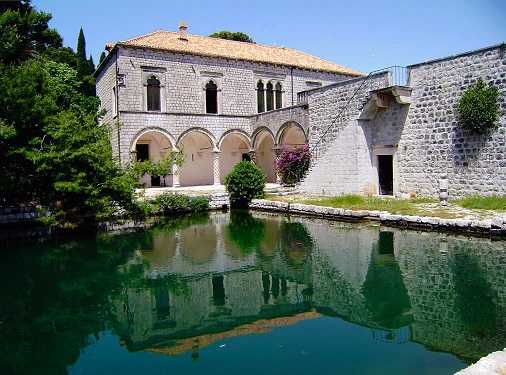
The upper surface of the enlarged wing, which is accessed from the main floor of the main building, is tiled and turned into a terrace, from which the view is extended to the surrounding area. Under it are water tanks and auxiliary facilities.
For summer villas on the shore, such a model has been achieved by the shrinking of the main building and the "orsan" – boat and fishing accessories storage - in the architectural ensemble as for summer villas Gundulić, Đurđević, Bunić, Bunić-Gradić along the coast of the Gruž Bay and Rastić in Rožat, Gučetić in Obuljen and in Mokošica.
Particularly interesting is the extremely asymmetrical basis of the villa Petar Sorkočević (1521) on the Lapad coastline, with a long vertical tiled terrace in the middle of the facade and the back wing of the lodge with painted logs. From the well-known villas on the slope, the open-air terrace at the floor level was marked by the summer house Getaldić (1516) in Suđurđani, Šipan island and Gundulić under Petka on Lapad, and the oldest examples are the Rector's Palace over Šipanska harbour (after the reconstruction of 1450).
For summer villas on the shore, such a model has been achieved by the shrinking of the main building and the "orsan" – boat and fishing accessories storage - in the architectural ensemble as for summer villas Gundulić, Đurđević, Bunić, Bunić-Gradić along the coast of the Gruž Bay and Rastić in Rožat, Gučetić in Obuljen and in Mokošica.
Particularly interesting is the extremely asymmetrical basis of the villa Petar Sorkočević (1521) on the Lapad coastline, with a long vertical tiled terrace in the middle of the facade and the back wing of the lodge with painted logs. From the well-known villas on the slope, the open-air terrace at the floor level was marked by the summer house Getaldić (1516) in Suđurđani, Šipan island and Gundulić under Petka on Lapad, and the oldest examples are the Rector's Palace over Šipanska harbour (after the reconstruction of 1450).

The ground floor is sometimes open to the garden, thus, P. Sorkočević's villa has a double beveled porch, partly under the façade, partially under a pergola orchard. It is supported by finely-worked stone columns with capitals, as well as a porch with a terrace facing the front of the Bunić-Kabogin summer holiday home in Batahovina. On the Gundulićeva (Rašica) summer house under Petka and Sorkočević-Natalićeva on Kantafigu in Gruž, the sloping porch is supported by massive construction.
The floor facade on some villas is opened on the corners with logs like Đurđević's summer residence on Lapad coast and Sorkočević-Natalićeva on Kantafig. Sorkočević's summer residence in Komolac at east corner ends with a log, and on the west side continues with a long gallery. Bunić-Kabogun summer villa in Batahovina, the west end of the floor ends with a loggia with two sloping openings, another example is the Skočibuha villa on Boninovo.
Its front is three-part, the middle part of the building was raised from the top to the bottom by a triangular porch on the ground floor and a three-story loft on the ground floor, like a smaller villa in the Farnese villa estate in Capraroli, north of Rome. There are some of the country's assemblies that have been paved in the function of a shady retreat and a gazebo, for example Gundulić in Gruž, V. Skočibuha in Suđurđ, Gučetić in Trsteno, Zuzoric in Čibača.
The floor facade on some villas is opened on the corners with logs like Đurđević's summer residence on Lapad coast and Sorkočević-Natalićeva on Kantafig. Sorkočević's summer residence in Komolac at east corner ends with a log, and on the west side continues with a long gallery. Bunić-Kabogun summer villa in Batahovina, the west end of the floor ends with a loggia with two sloping openings, another example is the Skočibuha villa on Boninovo.
Its front is three-part, the middle part of the building was raised from the top to the bottom by a triangular porch on the ground floor and a three-story loft on the ground floor, like a smaller villa in the Farnese villa estate in Capraroli, north of Rome. There are some of the country's assemblies that have been paved in the function of a shady retreat and a gazebo, for example Gundulić in Gruž, V. Skočibuha in Suđurđ, Gučetić in Trsteno, Zuzoric in Čibača.

Most representative country houses also have chapels. Some of them are distinguished by extraordinary sculptural elaboration, such as Crijević's on Pile and Gundulic's in Gruž. The most valuable Dubrovnik villas, by the equipment and the preservation, are the Vice Stjepović Skočibuha in Suđurđ on the island of Šipan from the second half of 16th century.
It has a spacious front and back garden with a network of crossed pergola paths and plenty of preserved garden plastic. The tower of the villa stand tall at the north side of the estate, along south side is raised garden terrace, a unique way of performance. It is made up of two levels, it has a walkway with a covered pergola and earth-shaded landscapes. There is also a chapel, and at the outer end of the pavilion, under the terrace are a mill and a repository.
The Dubrovnik Renaissance summer villas were made by Dubrovnik and Korčula builders and sculptors, and were built according to the instructions and under the supervision of the owners themselves. Exceptionally, it is rightly considered that the work of a foreign architect is involved in summer villa of V. Skočibuha on Boninovo and Crijević on Pila.
It has a spacious front and back garden with a network of crossed pergola paths and plenty of preserved garden plastic. The tower of the villa stand tall at the north side of the estate, along south side is raised garden terrace, a unique way of performance. It is made up of two levels, it has a walkway with a covered pergola and earth-shaded landscapes. There is also a chapel, and at the outer end of the pavilion, under the terrace are a mill and a repository.
The Dubrovnik Renaissance summer villas were made by Dubrovnik and Korčula builders and sculptors, and were built according to the instructions and under the supervision of the owners themselves. Exceptionally, it is rightly considered that the work of a foreign architect is involved in summer villa of V. Skočibuha on Boninovo and Crijević on Pila.
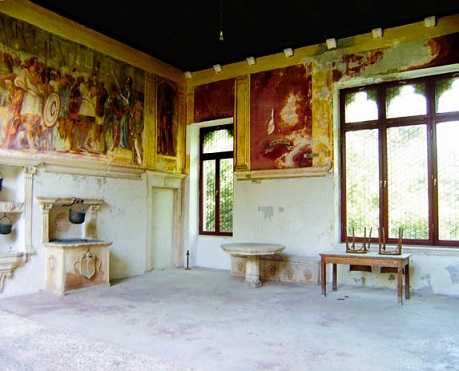
Many Renaissance Dubrovnik people, such as Nikola Vitkov Gučetić , Nikola Nalješković and Marin Getaldić, were proud of their countryside holiday villas in the “Župa Dubrovačka”, Trsteno and Ploče. They often stayed for a long time and created art works, Marin Držić was probably staying in one of the prominent summer holiday villas.
Examples of Baroque summer villas from the 18th century are the suburban castle Pucić on Pile, the summer villa residence of Bozdari, the work of Venetian architect Marin Groppeli, and the villa Bizzaro in Rijeka dubrovačka. By the end of 18th century on the territory of the Republic of Dubrovnik , mostly in Astarea and on the Elaphite Islands, about three hundred different holiday homes were erected. The exceptional number of such facilities on a very restricted territory is one of the special features of Dubrovnik holiday villas construction due to the specific social politics, landscaping and land dispersion. To date, only a small number of Renaissance Dubrovnik villas have been preserved.
Bunić's country villa is one of the atypical Dubrovnik summer holiday homes that has been developed on the upper floor with a terrace around the whole building that is based on the arcade of the front facade and allows communication around the first floor.
Examples of Baroque summer villas from the 18th century are the suburban castle Pucić on Pile, the summer villa residence of Bozdari, the work of Venetian architect Marin Groppeli, and the villa Bizzaro in Rijeka dubrovačka. By the end of 18th century on the territory of the Republic of Dubrovnik , mostly in Astarea and on the Elaphite Islands, about three hundred different holiday homes were erected. The exceptional number of such facilities on a very restricted territory is one of the special features of Dubrovnik holiday villas construction due to the specific social politics, landscaping and land dispersion. To date, only a small number of Renaissance Dubrovnik villas have been preserved.
Bunić's country villa is one of the atypical Dubrovnik summer holiday homes that has been developed on the upper floor with a terrace around the whole building that is based on the arcade of the front facade and allows communication around the first floor.

Building holiday villas in Dubrovnik area from Zaton, across the Gruž to Rijeka dubrovačka, started in the 14th century and was intensified in the 15th and 16th centuries, indicating a high level of housing culture in the territory of the former Republic. Dubrovnik summer villas stand out in a suitably chosen location, high quality construction and a unique architectural-horticultural approach, and are often built to serve more for vacation than for housing.
Many of the country villa estates, preserved to date, enchant by architectural spatial circles, square-shaped, by grouping buildings, often L-plans, for different purposes, from the country holiday home, chapel and orsan to the accompanying economic contents, gardens and mills.
One of them is the Dubrovnik Renaissance villa in Zaton from a noble family, according to architectural elements it is assumed that the construction was begun in the second half of the 15th century and later continued through several phases.
The newly restored estate, which is now rented for tourist purposes, is specific to its historical story and a junction of modernism and antiquity. Villa is located directly on the road that runs by the sea and is surrounded by a high fence wall, original private chapel of St. Jerolim, orchards and pool are located in beautiful 1400 square meters garden.
Many of the country villa estates, preserved to date, enchant by architectural spatial circles, square-shaped, by grouping buildings, often L-plans, for different purposes, from the country holiday home, chapel and orsan to the accompanying economic contents, gardens and mills.
One of them is the Dubrovnik Renaissance villa in Zaton from a noble family, according to architectural elements it is assumed that the construction was begun in the second half of the 15th century and later continued through several phases.
The newly restored estate, which is now rented for tourist purposes, is specific to its historical story and a junction of modernism and antiquity. Villa is located directly on the road that runs by the sea and is surrounded by a high fence wall, original private chapel of St. Jerolim, orchards and pool are located in beautiful 1400 square meters garden.
"A Journey into the Levant as It Once Was", book by John & Renata Fox, will take you on a journey through time, among others, you can visit Ragusa (Dubrovnik) and the summer residences of the noble Ragusans with beautiful gardens filled with orange and lemon trees, myrtle, laurel, cypress, jasmine, oleander, carnations and violets, and shaped by meandering paths covered with pergolas of sweet wine, stone walls, steps, terraces and belvederes, benches, seats, fountains and ponds, the gardens served the Renaissance ideal of linking man with nature.
"A Journey into the Levant as It Once Was" is based on the travelogues of thirteen British gentlemen, this book takes you on a journey into the Levant as it once was. As you make your way from London to Constantinople, you will visit cities, towns and islands, meet people and learn about ways of life, and you will get to know a British gentleman for whom travel was the "sweetest of all the pleasures in the world". The book tells a story about a past when a journey into the Levant was an experience to last a lifetime. It is a cultural account of a world long lost.
19th century - beginning of modern tourism and villas in Croatia

The oldest tourist facility in Croatia is Villa Angiolina in Opatija, Villa Angiolina is a cradle of Croatia tourism.
The first charm of Opatija was discovered by Iginio Scarpa, the patrician in Rijeka, in 1844 he built his villa in Opatija named Villa Angiolina for his deceased wife, which opened the way for tourism development.
That was the beginning of modern tourism in Croatia.

Villa Angiolina has one of the most beautiful parks in Croatia. This horticultural monument stretches over a surface of 3.64 hectares and is divided into 60 fields and has planted about 150 plant species.
A large number of plants originate from distant parts of the world and are not typical of this area. Among the many interesting plants, there are also Japanese camellia (Camellia japonica), which in time became a recognizable symbol of Opatija .
In the park there is the oldest building of Opatija, Church of Sv. James, mentioned for the first time in historical records in 1449.
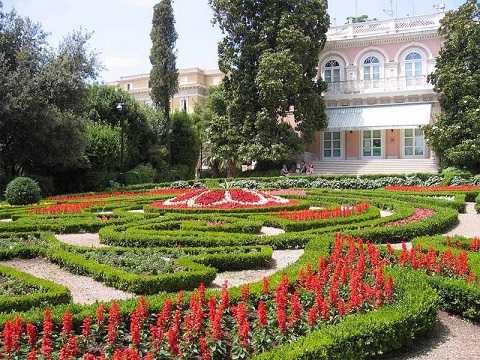
Opatija is known for its pleasant climate, and was relatively close to European rich people from Italy, Austria and other countries.
In the beginning, mostly owner’s friends stayed in Villa Angiolina and they first spread the voice of the beautiful village on the Adriatic coast and the healthy air.
Soon, the distinguished personalities are beginning to appear, among them the Austrian empress Maria Anna in 1860 and Croatian viceroy Josip Jelačić.
In the Villa Angiolina you can still feel the taste of Austro-Hungarian history and tourism as it was over 170 years ago.
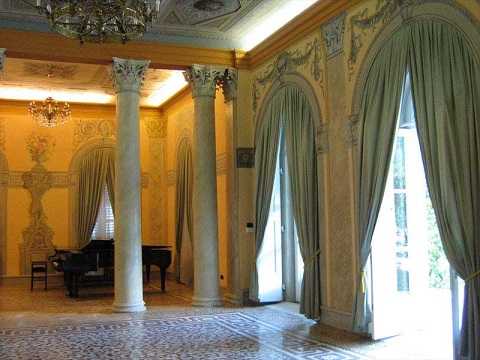
The entire Adriatic coast today is flooded with tourists, and a large number of people want to spend an annual vacation on the sea. 170 years ago that was not the case, it was considered that swimming in the sea would preferably be suitable only for children, but not for the elderly.
Many adults, especially women, who lived by the sea did not know how to swim.
Opatija has become the tourist destination of European elites since the late 19th century.
Today, the Croatian Museum of Tourism is located in Villa Angiolina.
